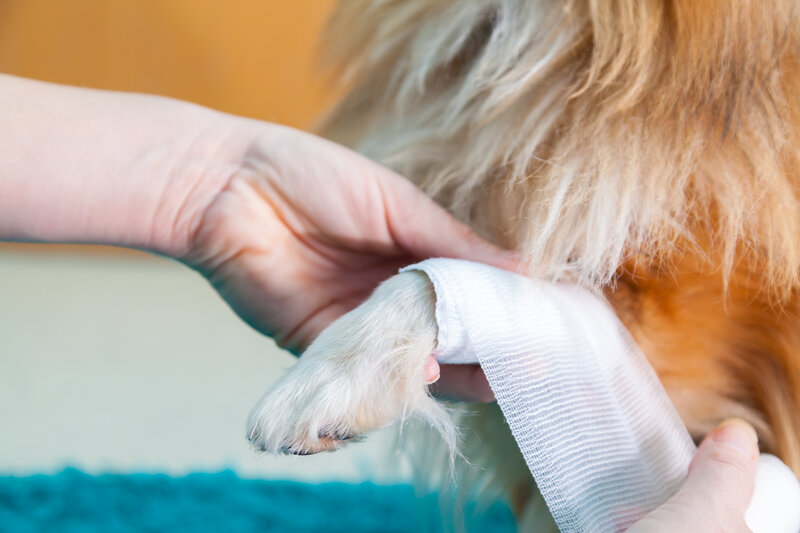
One of the best things you can do for your dog is learn basic first aid steps. You never know when your dogs - or someone else’s - might become injured. The more immediate and skilled the response, the better most dogs fare.
While your dog is certainly your priority, these reminders and skills may help to save the life of a dog you encounter at the dog park, on a walk, or alongside the road if they’re a stray.
Preventing illness or injury is the primary step to keeping your dog healthy and safe from catching - or developing - some of the most common canine diseases. This includes:
By providing a healthy foundation for your dog’s health, they’ll be able to recover more quickly from illness and injury.
We also recommend putting together a dog-specific kit for first aid for dogs. We put multiple kits together, leaving one at home, keeping one in the car's trunk, and maintaining a travel version in our dog-walking packs. This means you’re prepared to handle unexpected emergencies wherever you and your dog may be.
Things to include:
At home, we also recommend having a digital thermometer for taking your pet's temperature (Click Here to watch video instructions on taking a dog’s temperature).
Injured or ill dogs may be more aggressive or reactive than normal. Even though it’s hard, the best thing you can do when treating an injured dog is to:
One of the best things you can do in a dog first-aid situation is to remain calm and prevent further injury to yourself and your dog.
If you see that your dog is injured, bleeding, or bitten, get the dog to the closest flat area where they can lie down, and you can get a better look. A bandage or stabilize the injured area if you feel you can do so safely.
Keep the dog confined to as small an area as possible to prevent further injury while transporting them to the vet. If you can use hands-free features or have someone else with you, contact the veterinary office ahead of time so they know to expect you.
We do our best to keep dogs from chewing or eating things they shouldn’t. This is one of the reasons it’s so important to provide your dog with plenty of dog-safe chews and interactive toys. The more they safely satisfy their natural chewing and tearing tendencies, the less likely they are to ingest something they shouldn’t.
Even so, accidents happen. If your dog ingests or is exposed to poisonous or harmful household poisons/toxins:
Call your veterinarian or an emergency vet hospital for further instructions on how to proceed.
Dogs are very sensitive to heatstroke if they don’t have access to shade, airflow, and cool fresh water. Even a car that seems cool to a human and without proper ventilation can become stifling to a dog, especially if they’re thick-coated breed, are older, or overweight.
Common scenarios leading to heatstroke or heat-induced illness include leaving your dog in a parked car on a hot humid day, going on a long walk or hike without cooling or cold water breaks, keeping dogs outside for extended periods without shade or fresh water, and so on.
Signs of heatstroke include:
If your dog seems to be suffering from heat illness or stroke symptoms, move it to a cool area and fan it if you can. Soak small washcloths with room-temperature water and place them around their neck, armpits, and groin—and then refresh the towels every few minutes to provide a cooling effect.
DO NOT place them in a tub of cool water, as this can create a shock effect. Slow and steady cooling is essential to keep their system stable. See if they’ll drink cool water (unless they’re having seizures). Contact your vet and follow their instructions.
It’s very scary when a dog has a seizure. At the moment, all you can do is remove anything that could harm them until the seizure is over. Time it. Once it’s over, move them to a quiet space and keep them calm and comforted while you contact the vet.
It’s not uncommon for dogs to choke, and they usually get things up independently. It’s best to leave them to their own devices if they’re actively coughing, gagging, etc. unless you can easily remove the object from their mouth. If they struggle and aren’t breathing because the airway is blocked:
If the object isn’t dislodged quickly, get them to the vet immediately and contact them ahead of time if you can safely do so.
If your dog stops breathing:
Open their mouth and grasp their tongue so that it lolls out the side. This helps to clear the airway.
Keep this up as the pet is transported to the vet’s office or emergency vet hospital.
If your dog’s heart stops beating:
If your dog’s heart is not beating, begin performing rescue breathing as instructed above. Then, add chest compressions. Chest compressions for dogs should be performed to the rhythm of the song, “Stayin’ Alive” at 100 to 120 beats per minute.
How you perform these depends on the size and shape of the dog:
You’ll never regret being prepared for emergencies with some doggy first-aid know-how!
Would you like to learn more about how to keep your dog safe, along with some first-aid tips? Schedule dog training with Alternative Canine Training. Several members of our staff are also certified in dog CPR and first-aid. Our one-on-one and group classes are a great way to keep your dog socialized, learn the commands that help keep them safe, and learn a little more dog first-aid along the way.